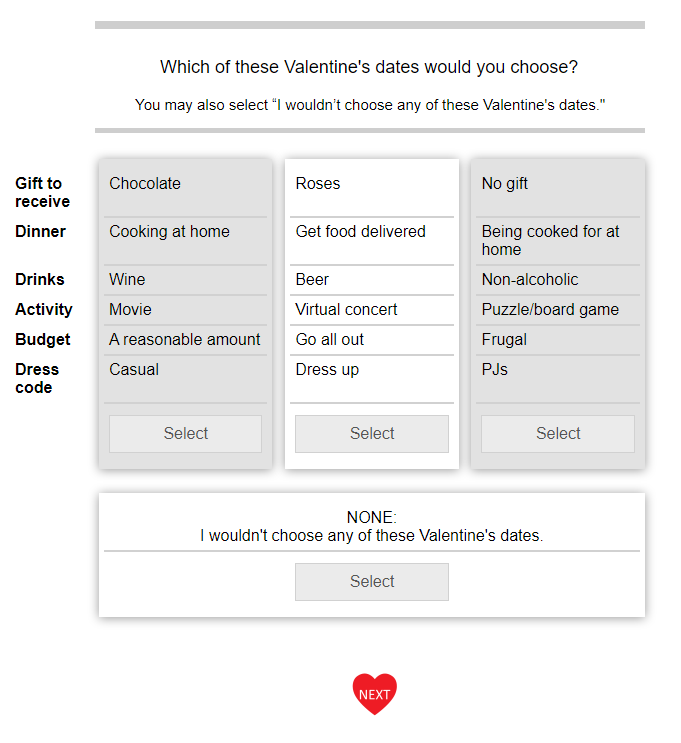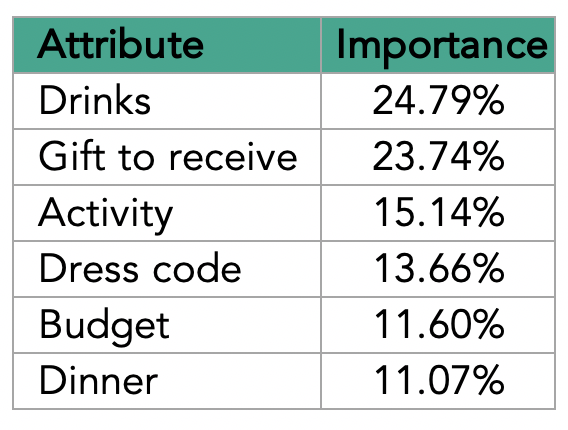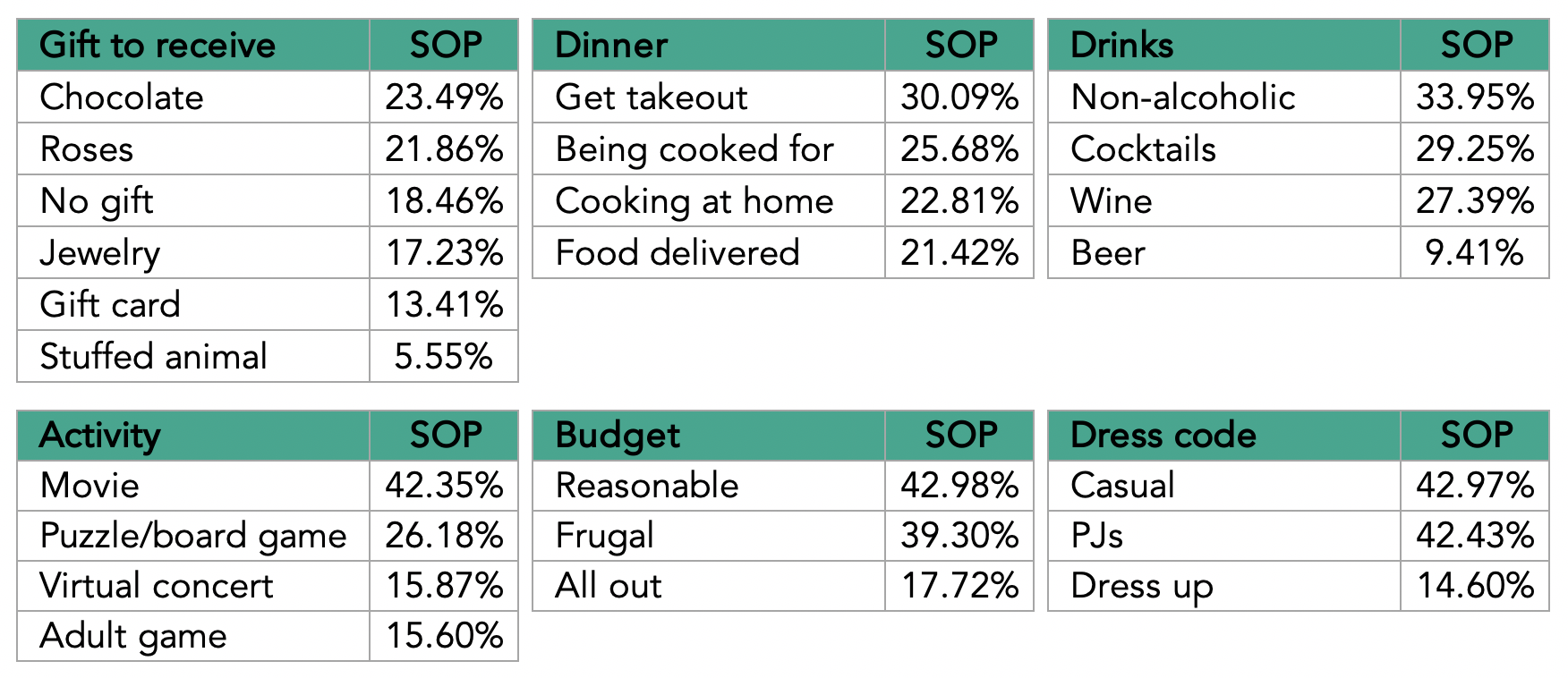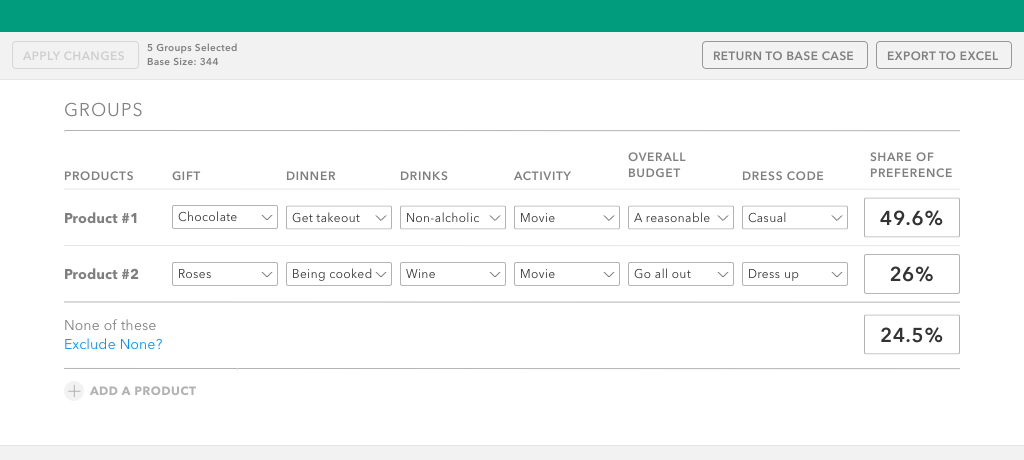You don't need Cupid, you need a conjoint
A weekend getaway or candle-lit dinner out on the town is likely not on your Valentine’s Day itinerary this Sunday. With COVID restrictions still in place and almost a year of staying at home with our significant others, planning a romantic date night may feel like an arduous (and maybe unnecessary) undertaking. We’ve done the hard work of planning for you — using a conjoint study and SmartLab, our proprietary panel — and found that couples don’t need extravagant plans to keep the romance alive this year.
How to build a great date
Conjoint analysis is an effective approach for measuring what consumers (or in this case, your Valentine) value in a product or service (an at-home celebration). It mimics real-life situations by asking people to weigh their options and choose the best combination of features. Through these decisions, consumers are making trade-offs and therefore indicating what features they value most.
To plan the perfect at-home date, we identified six attributes — a gift to receive, dinner plans, drink options, an activity, a budget, and a dress code — and selected three to six different options, or levels, within each of these categories. The survey presented respondents with 15 screens of potential date idea combinations and asked them to pick their favorite bundle or let us know if none of the combinations were appealing.

No need to go all out when you’re staying in
 The conjoint analysis determines how important the attributes are relative to one another, so we know which ones contribute most to preference. We found that drinks and gifts to receive were deemed the most important elements of the Valentine’s date. These attributes held the most weight for respondents, possibly being the deciding factor when choosing one date combination over another.
The conjoint analysis determines how important the attributes are relative to one another, so we know which ones contribute most to preference. We found that drinks and gifts to receive were deemed the most important elements of the Valentine’s date. These attributes held the most weight for respondents, possibly being the deciding factor when choosing one date combination over another.
On the other hand, the budget and dinner attributes carried the lowest importance. Maybe it really is the thought that counts?
We can also examine the attribute’s levels that are most preferred, known as the share of preference (SOP). Taking a look at the share of preference within the attributes with the highest importance, we can draw conclusions about what details are key to the optimal date.
- Your Valentine likely does not want to crack open a beer this Sunday — wine or a non-alcoholic beverage is preferred. Not only did beer have the lowest SOP at 9.41%, but it also didn’t show up in the top 20 combinations.
- The gift you give your Valentine bears some significance. We can see that in the gift category, chocolate and roses are pretty close in SOP, but the SOP for a stuffed animal is a clear outlier, making it a far less desirable gift. Skip the giant teddy bear or singing stuffed dog: no one really wants a stuffed animal for Valentine’s Day.
- Based on attribute importance and SOP, all dinner options were similarly acceptable. There isn’t much difference between the numbers, indicating that dinner options presented in the various combinations didn’t seem to influence a participant’s choice in overall date.

K.I.S.S. — keep it super simple
Based on the number of attributes and levels that we considered, there are 3,456 possible configurations of dates. That may seem like a lot of opportunities to get it wrong, but take a deep breath. In the case of selecting the best at-home date, our respondents indicated they’re looking for a low-key date night this year.
The top five combinations are pretty similar. No dressing up, no big budget, and no need to cook. And the night’s not ruined if you forget the wine.

Examining the top 20 combinations gave us more insight into just how laid-back this Valentine’s Day should be.
- Chocolate is the safest choice for a gift, but didn’t we all already know that? The only other gift option that showed up in the top 20 was receiving no gift at all. Easy enough, right?
- You can’t go wrong with watching a movie or getting takeout. Watching a movie was the only activity chosen in the top 20 combinations, and ordering takeout was a frequent winner. What movie? Takeout from where? Come on, you gotta do a little bit of the work yourself — or better yet, let your Valentine pick!
- Budgets in the top 20 were frugal or reasonable, and casual dress (whether sweatpants or PJs) seem encouraged. Could COVID and quarantining have influenced these answers? Nights out are generally associated with dressing up and spending money. Nights in are the opposite.
Connections and comparisons
So how can your company utilize Bellomy’s conjoint analysis to help you design swoon-worthy products or packages that your customers will love?

In this example, you can see how we used our simulator to compare one person’s idea of a “perfect date” (Product #2) to the winning date combination from our survey (Product #1). This simulator could be used to compare conjoint study results to your own hypothesis to results and see where you may be missing the mark with consumers. With this tool, we can also look at the characteristics of respondents, such as age. In our Valentine’s survey, the ideal date chosen by respondents under 40 aligned more closely with our final overall results than the ideal date chosen by respondents over 60.
Sealed with a... conjoint
Conjoint is an ideal technique for determining how people place value on separate attributes that make up a product or service — whether that is a Valentine’s date or a new offering from a provider. This analysis is an efficient way to explore and determine pricing, bundling, and the features that customers truly value.
No matter how you choose to celebrate Valentine’s Day this year, we wish you a safe and enjoyable holiday with those you love! If your company is looking to design a new multi-element offering and you want to conduct research to design the most desirable package options, Bellomy’s Advanced Analytics team is here to help with conjoint analysis. Reach out today to learn more.

